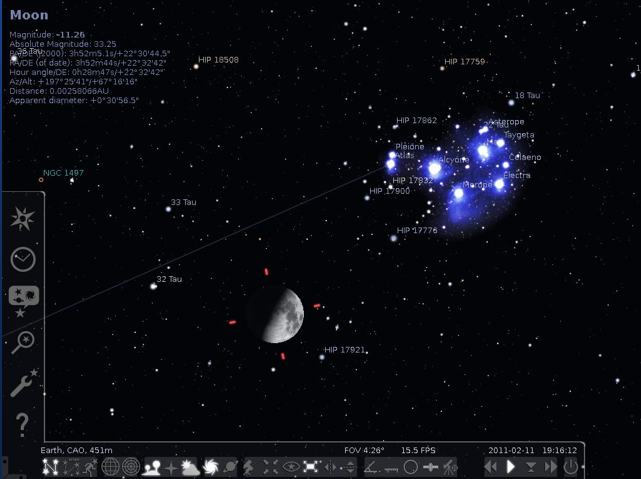Stellarium software introductory course
Introduction to Stellarium, level 1 (personal computer).
Part of the Stellarium Training Series.
Learn how to use the Stellarium planetarium software on your computer in a basic fashion.
Fee: Free to Members of the Royal Astronomical Society of Canada.
Course Overview
Stellarium is a powerful planetarium application available for Windows, Macintosh, and Linux computers. The free software can be used to learn the sky and plan astronomical observing or imaging sessions. If logging observations, it be used to corroborate and confirm celestial objects seen. Educators, presenters, and outreach volunteers may use the software for demonstrations, presentations, and What's Up discussions.

Participants will learn how to setup the software for a specific location, date, and time. They will learn how to view the simulated sky, zoom and pan, and search for and select celestial objects. Features such as gridlines, the meridian, sky settings, and red light mode will be explored. This will provide an amateur astronomer a basic overview of the Stellarium program.
Class sizes are limited. Classes are first-come first-serve and announced in the RASC Newsletter.
This 2-hour training course is not for the paid Stellarium app on smartphones or the Stellarium web app.
Over 300 RASC members have been trained on level 1 Stellarium!
What You'll Learn
Upon successful completion of this course, you will be able to use Stellarium in a basic fashion.
- Starting and Quitting the Stellarium Program
- Toggling Full Screen Mode
- Using the Side and Bottom Toolbars
- Using the Mouse and Keyboard to Control Stellarium
- Setting the Location
- Panning the Sky
- Selecting, Centring, and Deselecting
- Searching for an Object
- Zooming, Various Methods
- View the sky from any location on Earth
- Set the date and time to now, a past date, or a future date
- Accelerate, slow, or reverse the flow of time
- View constellations and stars, coordinate grid lines, and special reference lines
- View planets, surface details, and planetary moons
- View deep sky objects including double stars, galaxies, and nebulae
- Search for celestial objects by name or catalogue number
- Use Stellarium in night mode to preserve your dark adaptation
- Save your view preferences
- Controlling Time Flow
- Viewing Stars and Constellations
- Viewing Planet Labels and the Ecliptic
- Viewing Grid lines and Compass Points
- Changing the Other Sky Settings
- Changing Other Visual Options
- Flipping and Rotating the Field
- Viewing Deep Sky Objects
- Saving Settings or Preferences
- Getting Additional Help
Prerequisites
You must have a Windows, Mac, Linux computer.
You must have Stellarium for the desktop downloaded, installed, and working before the start of the class. It is free. https://stellarium.org/
This training is not for the paid Stellarium app on smartphones or the Stellarium web app.
You must have the Zoom meeting software installed and working. It is free. https://zoom.us/download
You must register for the Zoom session. Upon registering, the Zoom meeting details will be sent to you. It is strongly recommend you have a Zoom account or profile as it allows for a rich training experience. Set up a personal account for free.
It is recommended you have an external mouse for your computer.
It is best, when participating in a computer training course, that you have two screens. Connect your laptop to an external monitor, if possible. If you do not have two computer screens, consider running the Zoom on your smartphone or tablet to monitor the instructor's shared screen.
You must be comfortable with using your computer operating system and pointing device.
It is assumed participants have some minimal knowledge of astronomy, the sky, celestial objects and planets. We will not teach astronomical concepts. This is tool training.
Open mind.
Who Should Attend
This course is for members of the Royal Astronomical Society of Canada. It is one of the many benefits of membership.
If you are not a member of RASC, please join!
This course is intended for amateur astronomers who wish to gain a basic knowledge of the Stellarium planetarium application. Little or no previous experience with Stellarium is assumed.
If you are competent at the basics in Stellarium you're welcome to attend but the course may prove largely a review for you. Watch for our future higher level Stellarium training sessions where we will explore advanced features and capabilities such as custom landscapes, creating telescope-eyepiece or camera profiles, and connecting to an equatorial mount. We're also planning power-user courses for EPO volunteers.
Ahead of the Course
Ensure Stellarium is working on your computer. Start it, drag in the sky display to pan, click on a star or planet, and quit the program.
See the companion video (on Blake's YouTube channel) on downloading and installing Stellarium for more information.
If available, attend a webinar for an overview of Stellarium.
Procure a second monitor for your computer if possible for the fullest, richest training experience. See our companion video on how to set up your monitors for the training.
Install and test the Zoom meeting software. If you need assistance with this, let us know, and we can setup a test meeting in advance of the training.
Upcoming Course Dates
With sufficient interest, we may frequently run the introductory Stellarium course, once or twice a month. Courses will be scheduled on or near a full Moon.
Please register in advance for the software training course. To be notified of upcoming courses, sign up to the RASC Newsletter at the bottom of this page.
A minimum of 6 participants is required for a course to run. Space is limited to 10 to 15 online participants per session. If a class has insufficient attendance, it may be cancelled.
Any questions? Contact the administrator (software-training AT rasc DOT ca).
Return to the Stellarium Training Series hub.
